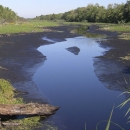Visit Us
The refuge's waterways and wetlands, bordered by ridges forested with oak, cypress, and gum trees, provide habitat for a wide array of wildlife. Visitors can enjoy fishing, wildlife viewing and photography, boating and hunting.
Located approximately five miles southwest of Houma, LA, Mandalay National Wildlife Refuge encompasses 4,212 acres of freshwater marsh, cypress-tupelo swamp and man-made canals, and is bisected by the Gulf Intracoastal Waterway. Most of the refuge, with the exception of a nature trail, is accessible only by boat. The freshwater marshes of the refuge are typically inundated each spring by flows transported from the Atchafalaya Basin 25 miles to the west, via the Gulf Intracoastal Waterway.
Activities
Visitors to the Mandalay National Wildlife Refuge can enjoy a variety of activities, including bird watching and wildlife observation, boating, paddling, hunting, photography and fishing. May through September can be hot and buggy. Bring sunscreen, plenty of water, and insect repellent.
Trails
Most of the refuge is accessible only by watercraft. A nature trail west of Houma located at the end of the gravel Rue de Manson off of Bayou Black Drive/Hwy 182 is the only land access. This trail leads to an elevated boardwalk trail and ends at an observation deck over the wetlands. Look for shorebirds, waterfowl and alligators from the observation point at the end of the trail.
Other Facilities in the Complex
Mandalay National Wildlife Refuge is managed as part of the Bayou Sauvage Urban National Wildlife Refuges Complex. The National Wildlife Refuges in Southeast Louisiana are part of a rich ecological system which includes marshes, pine and bottomland hardwood forests, lakes, barrier islands, swamps and bayous. Ranging from the marshy delta at the mouth of the Mississippi, to the wetlands that help protect New Orleans from hurricanes and provide a nursery to the fisheries that support the region’s food economy, to the wild bayous of the Atchafalaya Basin; your Southeast Louisiana National Wildlife Refuges preserve wildlife, habitat, and recreation opportunities representative of this unique part of the country.
All of the National Wildlife Refuges in Southeast Louisiana are open to public visits for nature-based recreational enjoyment. Priority public uses are hunting, fishing, wildlife observation, wildlife photography, environmental education, and interpretation.
The refuge complex headquarters is located at 61389 Hwy 434, Lacombe, Louisiana 70445. This site also hosts the Bayou Lacombe Visitor Center and has walking trails that wind through an historic garden site and along Bayou Lacombe.
Rules and Policies
Enjoy exploring and recreating in your National Wildlife Refuge. The refuge is open from sunrise to sunset.
To ensure healthy habitat and sustainable natural resources for your continued enjoyment, and to ensure visitor safety, the following are rules and prohibited activities:
- Hunters must abide by Louisiana state regulations. All hunters must read, sign, and have in their possession a signed copy of the Mandalay National Wildlife Refuge Hunting and Fishing Regulations.
- Airboats and marsh buggies are not allowed on the refuge.
- The use or possession of alcoholic beverages while hunting is prohibited.
- Non-toxic steel shot must be used in shotguns.
- Frogging or the taking of turtles is not allowed on the refuge.
- Possession or distribution of bait while in the field, and hunting with the aid of bait, including any grain, salt, minerals, or any non-naturally occurring food attractant, is not allowed.
- Cutting, removing, or damaging vegetation is prohibited.
- It is illegal to operate unmanned aircraft on refuge property without a special permit. (*A drone flight may be permitted occasionally for research or resource management purposes). If a drone operator stands beyond refuge boundaries and flies the vehicle over the refuge, fines can be levied if the drone is observed disturbing wildlife.
For a complete list of refuge use rules and regulations refer to the refuge Hunting and Fishing Regulations brochure here.




